|
Dreamgirls is weirdly like The Wizard of Oz. Neither one has a single shred of overtly gay content, and yet each of them has become an iconically gay piece of work. Wait til see you see the movie of
Dreamgirls (and you will, you know you will). You’ll see just what I mean.
Here’s a movie made by two white gay guys (writer-director Bill Condon and producer Laurence Mark) based on a Broadway musical made by a bunch of other white gay guys (director-choreographer Michael Bennett, playwright-lyricist Tom Eyen, composer Henry Krieger, and producer David Geffen) loosely based on the real-life story of four young black women from Detroit in the early ‘60s whose singing group crosses over from R&B to Top 40 and launches the superstardom of their lead singer.
Lord knows, gay guys aren’t the only people in the world who love the Supremes or the Broadway show loosely based on their story. But the same mysterious alchemy by which chubby nerdy mamma’s boys all over the world identify with a spunky pubescent girl in pigtails and a checked gingham dress singing “Somewhere Over the Rainbow” seems to operate inside the mythic landscape of
Dreamgirls.
The show/the movie/the myth taps into the magic power of Motown (that insanely productive hit factory that, along with the Beatles, produced the soundtrack for life in the ‘60s), a power that is concentrated exponentially into the Supremes’ three-minute masterpieces. I swear my first erotic experience, as a baby fag growing up on an Air Force base in Japan, had less to do with my genitals than with my first exposure to the Supremes. Lying in bed with my transistor radio pressed against my ear late one Saturday night in 1964 (the one hour of the week you could get “The Hit Parade”), I heard those haunting handclaps and a voice out of the darkness moaning, “Baby, baby…baby, don’t leave me…ooh, please don’t leave me all by myself.” Where did our love go? Has any more profound question ever been uttered in the universe?
You don’t have to have been present at the creation to be affected by Motown, either. Everyone alive who’s ever been to a supermarket or Starbuck’s has mainlined “I Heard It Through the Grapevine,” “You Can’t Hurry Love,” and other Motown classics. Still, there’s something about Diana Ross, the little-bitty stick of a girl-woman with the little-bitty kittenish voice and the big eyes and the big hair, that has a cosmic energy of its own and comes to stand for so much more than pop songs. I mean, tons of singers are as good or better, but how many drag queens do Gladys Knight?
It’s the energy thing, some cross between Disney fairy-tale and Joseph Campbell-style heroic archetype, that Tom Eyen and Henry Krieger wanted to make a Broadway musical about.
Dreamgirls had something to do with race in America, with black pride and economic self-empowerment. It had something to do with the new possibilities of fame and fortune in the post-industrial mass-media age. It had something to do with the Ugly Duckling and Sleeping Beauty and
All About Eve. (The white gay equivalent to the Effie White story is
Torch Song Trilogy, in which Harvey Fierstein plays a romantically masochistic character whose body image and cultural references exist in opposition to the gay culture of disco and drugs.) But mostly
Dreamgirls had to do with a whole bunch of exciting young black performers in fabulous costumes doing crisp, catchy numbers that knowingly referred to Motown and its musical sources while simultaneously commenting on the action of the play.
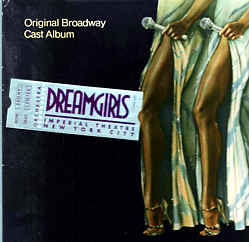
For one thing, there was Jennifer Holliday, who was a force of nature all by herself. The rest of the original cast was pretty damn good, but she brought down the house every night at the end of act one with “And I Am Telling You I’m Not Going.” You may have seen on YouTube
the clip from the Tony Awards show that year – it gives you a pretty good idea of how intense and astonishing she was. It’s one of the legendary performances in Broadway history. And Michael Bennett, who masterminded
A Chorus Line, was at the top of his form staging Dreamgirls. He’d been a dancer on the ‘60s pop-music show
Hullabaloo and had huge affection for that period. He also loved backstage stories, and he had incredible state-of-the-art stagecraft at his disposal, including a series of lighting towers that became characters in themselves, swiveling and flashing and moving like high-tech Pips. It was the best rock concert you’ve ever seen. And here’s the thing about Broadway: It’s one thing to see top-of-the-line rock/pop/soul stars (Prince, Bruce, Madonna) in gigantic concert halls and stadiums – it’s a whole ‘nother thing to experience that kind of energy in a relatively intimate Broadway theater that seats only 1400 people. And done with impeccable verve and attention to detail. Bennett and his collaborators were like the “doomed queens” in Andrew Holleran’s
Dancer from the Dance: "They were bound together by a common love of a certain kind of music, physical beauty, and style -- all the things one shouldn't throw away an ounce of energy pursuing, and sometimes throw away a life pursuing."
Bill Condon may or may not put himself in that category. But he was blown away seeing
Dreamgirls on Broadway as a young writer in his 20s. A couple of decades later, having built up industry cred as writer-director
(Gods and Monsters, Kinsey) and hired-gun screen adaptationist
(Chicago), he had a golden moment of being able to name his next project, and
Dreamgirls was number-one on his list. He managed to win over David Geffen, who’d been keeper of the flame after Michael Bennett’s untimely death in 1987, with his love of the original Broadway production. The movie is surprisingly faithful to the Broadway show in ways that will make the relatively small theatergoing crowd happy, while pulling in hot hot hot contemporary pop energy that make it fly for the young folks – namely, Jennifer Hudson and Beyonce.
The audience for the screening I attended in Times Square was wall-to-wall industry fags and take-no-shit black chicks, none of them strangers to Prada. There were clearly some major
Dreamgirls-heads in the crowd who’d had seen the Broadway production, because they gave recognition applause to Loretta Devine, the original Lorell, who plays a tiny part late in the movie. (Lorell is a pretty thankless part – she’s Not-Effie and Not-Deena. But she has one of the best lines. Early on Effie is fussing about her hair and her outfit, and Lorell finally says,
“Do you got the same wig as me? Do you got the same dress as me? Then shut up!”) And they gave three separate ovations to Jennifer Hudson in the course of “And I Am Telling You” – which on film is even more intense than in the theater, a five-minute uninterrupted monologue at high emotional pitch, focused almost entirely on Hudson’s face…and girlfriend nails it! A big part of the thrill of
Dreamgirls the movie is just watching these fantastic performers really perform, not just in tiny five-second bites edited to look impressive. The story’s pretty gripping, the writing is good, you’re emotionally hooked in, and then these performances are practically orgasmic.
As I said to John Calendo in an e-mail exchange, when I first heard about the movie casting I was worried about Beyonce. Listen to how incredibly gay that sounds. “Worried about Beyonce in
Dreamgirls” is something that only a Big Queen in 2006 would admit! But it’s true. I knew she was part of Destiny’s Child, but that’s a girl-group that I have no emotional associations with. I loved her “Crazy in Love” single, but that seemed to ride mostly on fabulous production, less on her singing. Could she really play some version of Diana Ross? Turns out that Deena Jones is not all that demanding a role dramatically, nothing Beyonce can’t do. And the movie uses her in a very interesting and canny way that entirely fits the material – she is treated as a beautiful surface that can be endlessly manipulated. Early in the movie she’s a mousy mamma’s girl receding in the background behind Jennifer Hudson’s hefty, aggressive Effie. The first moment she steps forward with eye makeup and false eyelashes – kazam! It’s like the moment when
The Wizard of Oz goes color.
What’s possible with a beauty like Beyonce is precisely what Curtis Taylor Jr. (the Berry Gordy character, played by Jamie Foxx) is doing when he moves idiosyncratic Effie to the background and puts smooth, almost characterless Deena up front. When there’s less personality coming out of the person, the audience can project its own fantasies onto her more readily. The most mesmerizing Beyonce scene in
Dreamgirls is a sequence that ostensibly replaces what in the Broadway show was a photo shoot for
Vogue. In the movie we get to look at one fabulous glam shot of Deena after another while Curtis is singing “When I First Saw You,” a song that’s basically about the sick combination of love, personal ambition, and commercial calculation he’s projected onto her from the beginning.
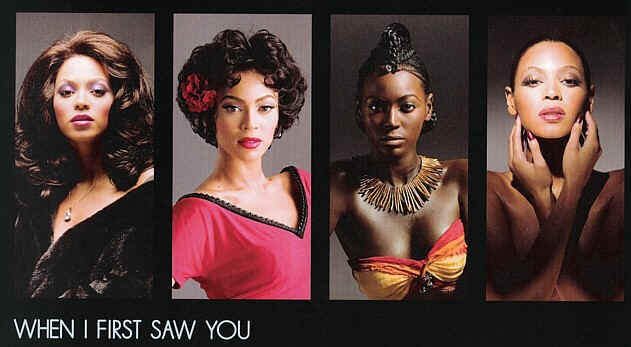
The least convincing Beyonce moment for me is her big solo at the end called “Listen,” where she’s asserting her independence from Curtis. They had to write her a new song that could be a single, but the song is kinda crappy, and she sings it in that all-over-the-place
American Idol style that just doesn’t suit her voice. (Its corollary in the Motown canon might be Miss Ross’s solo version of “Endless Love” – NOT the Lionel Richie duet – in which she attempts to caterwaul like, oh, Patti Labelle. Not successful, but a valiant effort.)
The other really fun thing about the movie is its appeal to pop-music trivia buffs (like me, and anyone who gobbled up the long interview with Stephin Merritt in the liner notes for the Magnetic Fields’
69 Love Songs). In a way that’s much more engaging than watching a official documentary of the period, this roman-a-clef version of the Motown narrative makes tons of offhand references to stuff that either flies by unnoticed or makes you giggle with the joy of remembering long-forgotten tidbits. Effie starts out as an apocryphal version of Florence Ballard, one of the original Supremes, although composer Henry Krieger says he modeled her equally much on Etta James. In the movie, Condon sprinkles her with some flakes of Aretha. She gets a new song (“Love You I Do”) when she’s aglow with love for Curtis that’s a girlish and easygoing mix of Aretha’s “Don’t Play That Song” and maybe Natalie Cole’s “This Will Be.” After she leaves the Dreams, she goes through a daishiki-wearing moment a la Aretha
Amazing Grace album cover. (Some of the secret stars of the movie are costume designer Sharen Davis, makeup queen Tym Shutchai Buacharern, and hair diva Camille Friend.)
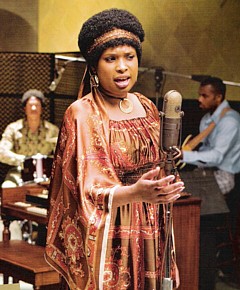
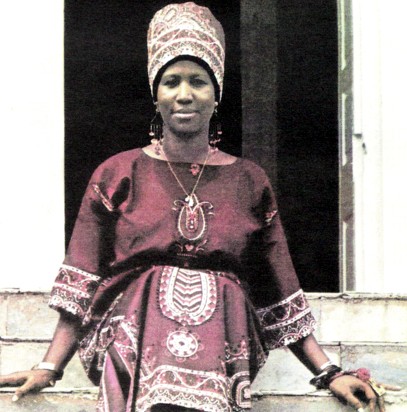
James “Thunder” Early, the R&B pioneer who first hires the Dreams as backup singers, has always been some version of James Brown (Krieger would also say Jackie Wilson). Which is why Eddie Murphy is perfect casting – he’s oily, he’s funny, and he can sing. Remember the “Singers” riff on his second comedy album, where he did a tearful Michael Jackson (“Tito, bring me some tissue!”) and a perfect demonstration of how you can’t understand a word
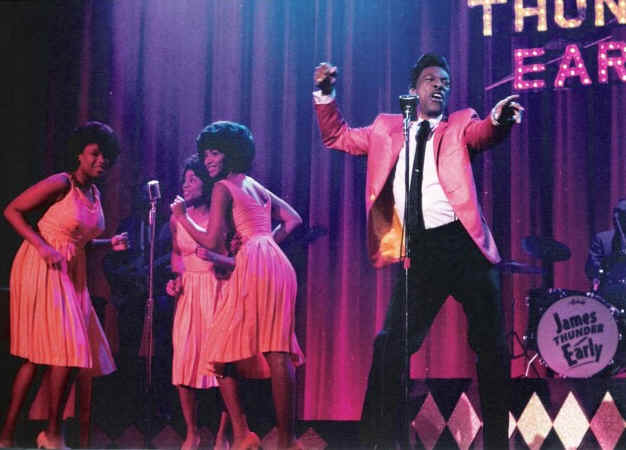
James Brown sings? Only here, Eddie Murphy really does sing, and the movie has him morph from greasy pioneer to supper-club act to Marvin Gaye in his socially-conscious wool-cap period, represented by a rather lame new song called “Patience” that’s meant to remind us of “What’s Goin’ On.”
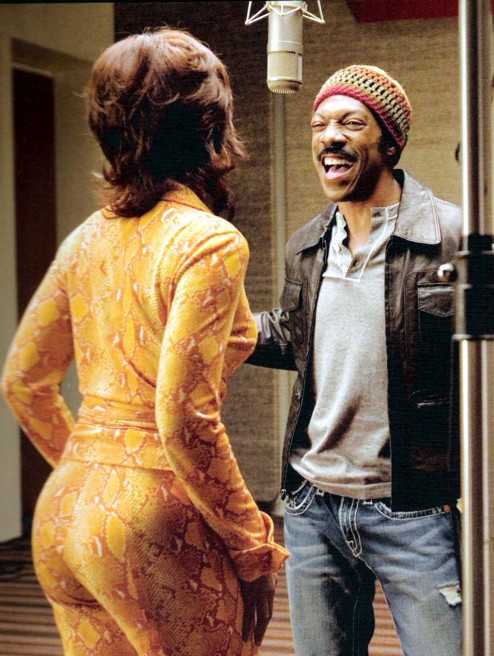
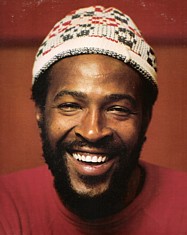
The movie also tucks in some bits that weren’t in the musical, like glimpses of an all-boy family act called the Campbell Collection, whose song “Perfect World” uncannily mashes “I Want You Back” and “ABC.” Had you forgotten that their first album was called
Diana Ross Presents the Jackson 5?
A lot of people dis the original Broadway score of Dreamgirls, none more vociferously than Nightcharm’s own John Calendo, and reviewing the movie David Edelstein seconds that emotion in
New York Magazine: “The onstage numbers get stale after two choruses, and the old-fashioned Broadway ones in which people sing their thoughts are Lite FM sludge, like Lionel Richie doing recitative at the Met.” Ouch! He’s got a point. But hey, Lionel Richie is undeniably a part of Motown history.
But to judge the songs by themselves is to miss the point. Each of them parodies and pays homage at the same time to the deliriously inspired/insipid teen-angst poetry of Holland-Dozier-Holland. And it really helps to have visuals to appreciate the songs. To get the full effect of “Stop! In the Name of Love,” you have to picture Miss Ross in a slinky gown with her arm outstretched and her palm facing you, like some traffic cop in Bergdorf Goodman.
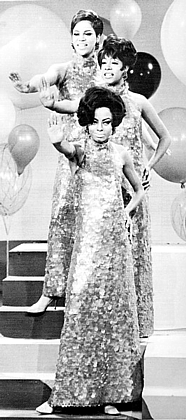
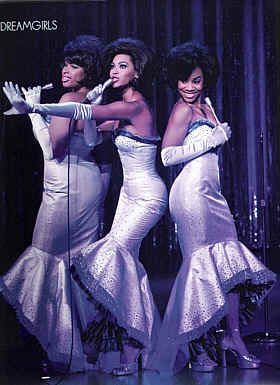
The onstage numbers in Dreamgirls all have hilarious classic choreography that acts out anything you can act out (“breakin’ breakin’ up over you”). The segue from CC’s demo version of “Cadillac Car” to Jimmy Early’s gritty studio version to the pink-cheeked Pat Boone Junior hit succinctly and amusingly captures the phenomenon of black music being co-opted by white artists. “Steppin’ to the Bad Side” dramatizes black record companies learning to play hardball to a thrilling tune reminiscent of the Temptations’ “socially relevant” hits “Ball of Confusion” and “Cloud Nine.” “One Night Only” illustrates the contrast between old-fashioned masochistic female romancticism (Effie’s ballad version, where she’s the victim of a man who doesn’t have time for her) and self-empowered “do-me” feminism (Deena Jones’s disco version, where she’s the modern businesswoman
surrounded by her super-gay posse and who doesn’t have time for anything more than a one-night stand). And one song that to me surpasses its Motown counterpart is the Dreams’ final number, “Hard to Say Goodbye,” clearly modeled on the Supremes’ ickier “Someday We’ll Be Together.”
I think the severely abridged original Broadway cast album does a disservice to the score. You get the best sense of the stage musical from the uncut
Dreamgirls in Concert double-CD which includes all the dialogue, not to mention fantastic performances by the cream of contemporary Broadway (Lillias White as Effie, Audra McDonald as Deena, Heather Headley as Lorell, Norm Lewis as Curtis Taylor, and Billy Porter as Jimmy Early). It’s not something you’re going to listen to everyday. But a couple of years ago I spent some time in Montana and during an all-day drive across the state had
Dreamgirls cranked up on the car stereo. I felt so gay! The deluxe edition of the movie soundtrack has its own trove of treasures – most notably an ecstatic dance remix of Jennifer Hudson doing “And I Am Telling You.”
So…run out and see the movie, preferably at the biggest movie theater with the most comfortable seats and the best sound system, and let us know where your obsessions tap into the
Dreamgirls saga.
Nightcharm.com, December 15, 2006
|